上海生命科学院细胞生物学网络资源
中国科学院1993年研究生入学试题《细胞生物学》试题及答案详解
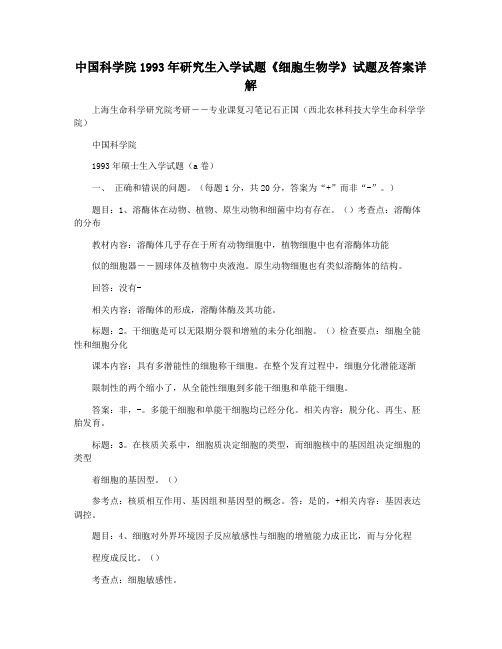
中国科学院1993年研究生入学试题《细胞生物学》试题及答案详解上海生命科学研究院考研――专业课复习笔记石正国(西北农林科技大学生命科学学院)中国科学院1993年硕士生入学试题(a卷)一、正确和错误的问题。
(每题1分,共20分,答案为“+”而非“-”。
)题目:1、溶酶体在动物、植物、原生动物和细菌中均有存在。
()考查点:溶酶体的分布教材内容:溶酶体几乎存在于所有动物细胞中,植物细胞中也有溶酶体功能似的细胞器――圆球体及植物中央液泡。
原生动物细胞也有类似溶酶体的结构。
回答:没有-相关内容:溶酶体的形成,溶酶体酶及其功能。
标题:2。
干细胞是可以无限期分裂和增殖的未分化细胞。
()检查要点:细胞全能性和细胞分化课本内容:具有多潜能性的细胞称干细胞。
在整个发育过程中,细胞分化潜能逐渐限制性的两个缩小了,从全能性细胞到多能干细胞和单能干细胞。
答案:非,-。
多能干细胞和单能干细胞均已经分化。
相关内容:脱分化、再生、胚胎发育。
标题:3。
在核质关系中,细胞质决定细胞的类型,而细胞核中的基因组决定细胞的类型着细胞的基因型。
()参考点:核质相互作用、基因组和基因型的概念。
答:是的,+相关内容:基因表达调控。
题目:4、细胞对外界环境因子反应敏感性与细胞的增殖能力成正比,而与分化程程度成反比。
()考查点:细胞敏感性。
回答:没有。
细胞对外界因素的敏感性受分化程度的影响,但不成正比。
相关内容:细胞增殖和细胞分化。
78上海生命科学院研究生入学考试——石正国主编《西北农林科技大学生命科学学院》题目:5、细胞分化过程一般是不稳定的,可逆的。
()考查点:细胞分化的概念。
教材内容:在个体发育中,同一细胞类型在细胞分裂后逐渐改变形状和节律构、功能上形成稳定性差异,产生不同的细胞类群的过程称细胞分化(celldifferentiation)。
回答:没有-题目:6、同一有机体的不同组织细胞核仁的大小和数目都有很大的变化,这种变磷酸化与细胞中蛋白质合成的活跃程度有关。
中国科学院2002年研究生入学试题《细胞生物学》试题及答案

中国科学院上海生化与细胞所2002:[细胞生物学B]"试题及答案"考试科目:细胞生物学(B)报考单位:中科院上海生命科学院报考方向:神经生物学一、是非题:20题,每题1分,共20分。
答"是"写" ",答"非"写"-",答案写在括号内。
1.细胞的体积有大小不同,但各种细胞核的大小常县殊不大。
( )2.植物细胞通常不表现动物细胞所表现的衰老过程。
( )?3.体外培养的细胞,一般保持体内原有的细胞形态民。
(-)4.G蛋白偶联受体被激活后,使相应的G蛋白解离成α、β、γ三个亚基,以进行信号传递(-)5.膜蛋白的跨膜区均呈α螺旋结构。
( )?6.胞外基质(extracellular matrix)主要用于用于维持组织结构,对细胞功能的影响不大(-)7.中心粒和基体均不具有自我复制性质(-)8.肌球不具有ATP酶活性。
( )9.细胞中所有的微丝均为动态结构。
(-)10.与微丝不同,中间纤维蛋白合成后,基本上均组装为中间纤维,没有大量游离的单体存在( ) 11.核糖体存在于一切细胞内。
(-)12.在所有动力动物细胞中,中心体是主要的微管组织中心。
(-)13.将光驱动的质子泵----噬盐菌菌紫质(bacteriorhodopsin)与ATP合成酶置于同一脂质体中,在光照下可由ADP和磷酸产生ATP。
( )14.蛋白核定位信号(nuclear localization signal)富含碱性氨基酸。
( )15.细胞周期中,在G1/S 和G2/M处都有检验点(chekpoint)。
( )16.中国科学家在人类基因组计划中完成了约1%基因组的测序。
( )[答题技术:这样的题目一定是正确的!因为中国人好大喜功。
]17.永生细胞和癌细胞的主要共同点就是既没有细胞分裂次数的限制,也没有细胞间的接触抑制。
(-) 18.有亮氨酸拉链模式(Leucine-Zipper motif)的Jun和fos蛋白质是以二聚体或四聚体的形式结合DNA 的。
网络资源在细胞生物学教学中的应用与探讨
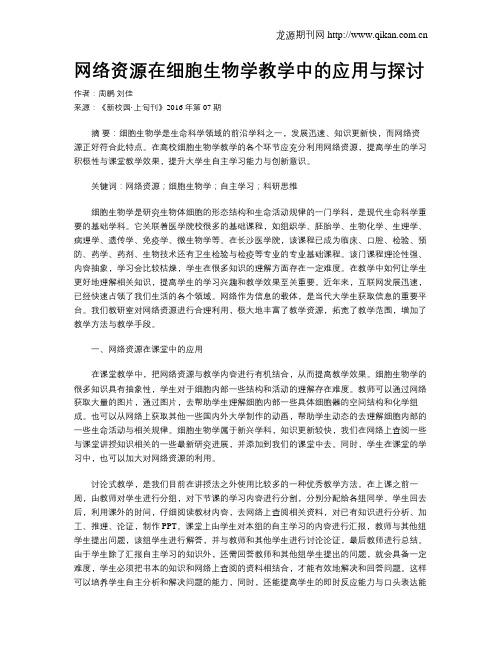
网络资源在细胞生物学教学中的应用与探讨作者:周鹏刘佳来源:《新校园·上旬刊》2016年第07期摘要:细胞生物学是生命科学领域的前沿学科之一,发展迅速、知识更新快,而网络资源正好符合此特点。
在高校细胞生物学教学的各个环节应充分利用网络资源,提高学生的学习积极性与课堂教学效果,提升大学生自主学习能力与创新意识。
关键词:网络资源;细胞生物学;自主学习;科研思维细胞生物学是研究生物体细胞的形态结构和生命活动规律的一门学科,是现代生命科学重要的基础学科。
它关联着医学院校很多的基础课程,如组织学、胚胎学、生物化学、生理学、病理学、遗传学、免疫学、微生物学等。
在长沙医学院,该课程已成为临床、口腔、检验、预防、药学、药剂、生物技术还有卫生检验与检疫等专业的专业基础课程。
该门课程理论性强、内容抽象,学习会比较枯燥,学生在很多知识的理解方面存在一定难度。
在教学中如何让学生更好地理解相关知识,提高学生的学习兴趣和教学效果至关重要。
近年来,互联网发展迅速,已经快速占领了我们生活的各个领域。
网络作为信息的载体,是当代大学生获取信息的重要平台。
我们教研室对网络资源进行合理利用,极大地丰富了教学资源,拓宽了教学范围,增加了教学方法与教学手段。
一、网络资源在课堂中的应用在课堂教学中,把网络资源与教学内容进行有机结合,从而提高教学效果。
细胞生物学的很多知识具有抽象性,学生对于细胞内部一些结构和活动的理解存在难度。
教师可以通过网络获取大量的图片,通过图片,去帮助学生理解细胞内部一些具体细胞器的空间结构和化学组成。
也可以从网络上获取其他一些国内外大学制作的动画,帮助学生动态的去理解细胞内部的一些生命活动与相关规律。
细胞生物学属于新兴学科,知识更新较快,我们在网络上查阅一些与课堂讲授知识相关的一些最新研究进展,并添加到我们的课堂中去。
同时,学生在课堂的学习中,也可以加大对网络资源的利用。
讨论式教学,是我们目前在讲授法之外使用比较多的一种优秀教学方法。
中科院上海生科院生物化学与细胞生物学研究所

中科院上海生科院生物化学与细胞生物学研究所2010年招收攻读博士学位研究生招生简章我所博士生培养的目标是德、智、体全面发展,在本学科内掌握坚实宽广的基础理论和系统深入的专门知识,具有独立从事科学研究工作的能力,在本学科或专门技术上做出创造性成果的高级科学技术专门人才。
学制三年。
二、报考条件:1.拥护中国共产党的领导,坚持四项基本原则,品德良好,遵纪守法,勤奋好学,决心为我国社会主义现代化建设服务。
2.已获得硕士学位的在职人员;应届硕士毕业生(最迟须在录取前能够取得硕士学位)。
3. 身体健康状况符合培养单位规定的体检要求,年龄一般不超过45周岁。
4.现为委托培养或定向培养的应届毕业硕士生、拟报考委托培养或定向培养的考生以及原为委托培养或定向培养硕士生,现正在履行合同中服务年限的在职人员考生,须征得委托培养或定向培养单位的同意。
5.现役军人考生,按中国人民解放军总政治部的规定办理。
三、报名和考试时间、地点及有关手续1、初审2、正式报名手续:1)经初审后,符合报考条件者,缴纳报名费150元,一寸免冠正面报名照3张,填写报考博士生各类表格。
如属委托或定向考生需持人事档案所在单位并由人事部门开具的同意报考的证明或介绍信。
2 ) 考生需将下列正式报名材料于2009年12月8日----2010年1月25日前寄到生化细胞所研究生办,材料经审核后,方可发出准考证。
⑴填写好的报考攻读博士学位研究生登记表;⑵两位副教授(或相当职称)以上专家的推荐表;⑶硕士课程学习成绩单,硕士学位论文全文和评议书;⑷硕士学位证书复印件(应届毕业硕士生必须在录取前补交)或证明书;⑸政审表。
3、网上报名时间:地址:上海市岳阳路320号邮政编码:2000315、考试科目和时间:①英语(中科院统一命题)、②生物化学与分子生物学、③细胞生物学、④复试(硕士论文报告或专业工作报告)时间:业务课1:2010年3月19日上午8:30~11:30业务课2:2010年3月19日下午13:30~16:30英语:2010年3月20日上午8:30~11:30以准考证时间为准注:外语口试测试在复试中进行。
2019年上海师范大学生命科学学院拟录取硕士研究生名单公示

吕**桥 1051*******3975 292
沈**君 1443*******0137 309
万**冉 1038*******5224 349
汪**伟 1055*******6091 294
王**超 1002*******0236 304
杨**薇 1063*******4435 305
弋**昕 1028*******5196 318
马**静 1053*******7113 329
潘**琦 1028*******9805 305
沈**利 1026*******0008 304
王**涛 1443*******0043 290
张**蝶 1063*******2769 375
白**晨 1001*******6887 290
戴**柔 1027*******3315 376
生命科学学院 生态学
生命科学学院 生态学
生命科学学院 生态学
生命科学学院 生态学
生命科学学院 生态学
姓名 准考证号
初试成绩
方**洁 1035*******4516 300
冯**艳 1055*******2107 313
李**翀 1027*******4899 373
李**祺 1027*******4517 370
复试成绩 247 247 259 260 254 244 252 241 216 265 268 252 274 247 265 272 241 256 254 243 268 254 254 255 242 252 237 254 254 265 251 252 244 254 249 247 250 254 247 247 251 261 244 245 254 247
生物学常用网站

互联网动物学协会
/home.html
该协会的目的是帮助和支持其他非盈利教育组织。
热带生物学协会(Association for Tropical Biology) /atb
国际蜜蜂研究协会 /ibra/index.html
生物学常用网站
science杂志
美国生物技术信息中心(NCBI)
nature杂志
人类基因组数据库(NCBI)
/dBest/index.html
生物科学学术机构
生物学组织 /afagen/depts/orgs.html
该网站提供生物学学术组织的链接目录。
生物学学术机构 http://www.lib.uwaterloo.ca/society/biol_soc.html
该网站信息由加拿大滑铁卢大学提供,提供生物科学学术机构索引。
该网站介绍一个正在设计临床试验和建立实验环境的生物信息学和药理学实验室。
生物多样性和生物群落
该网站为系统学家和生物学家提供信息资源。
生物学家虚拟会场 http://bioinformatics.weizmann.ac.il/BioMOO
日本DNA数据库(DDBJ)
http://www.ddbj.nig.ac.jp
science o信息资源(PIR)
/Dan/proteins/pir.html
Cell杂志
生物技术协会
哈佛生物学实验室 /genome.html
该网站提供生物技术研究资源,内容包括访问全球典型有机物资料库及其他生化资料库,并链接到哈佛大学各生物学实验室。
计算生物学和信息学实验室(CBIL)
生物方面的网站

好的生物学方面的网站41个1.http://cellbio.u / 得克萨斯大学细胞生物学研究生培养方面的网站。
2.http://cimewww.epfl.ch 一个电镜方面的网址。
3./ Geoge Madson 大学的教学网站4./bio/bio181/BIOBK/BioB ookCELL2.html 一个细胞学教学网。
5./bio/B IO181/BIOB K/BioB ookTOC.html 老外的细胞生物学在线图书。
6./home0/ecoli/molecula/home.htm 一本分子生物学简明读本。
7./photobase/cgris图库.html 种质资源图库。
8./courses/ 加州大学伯克利分校细胞与分子教学网站,精彩!9./Science/Cell_Biology/ 细胞生物学网址,精彩。
10./ 37度网,有许多不要钱的医学书籍和图片,精彩。
11./ 动物图片12./micromenu.htm 各种古董显微镜,图片非常精彩,全面。
13./ 生物软件网,有大量材料和网址。
14./subject/biology/ 中基网生物,有动植物图片。
15./Cell-biology/ 关于细胞膜、细胞骨架方面的讲述的确不错。
16./ 精彩的电镜照片,让你垂涎三尺。
17./~lthompso/bgy53/ 普通生物学教学课件18.http://www.grt.kyushu-u.ac.jp信号转导部分很好。
19.http://www.grt.kyushu-u.ac.jp/spad/menu.html 细胞因子信号转导。
20./faculty/Eng manj/bio2114/power/cell/ 细胞生物学教学网站,有很多幻灯片。
21./~newmanl/GraphicsCatalog.html 细胞生物学图片。
22./exhibits/gallery/fluorescencegallery.htm 荧光显微镜照片。
细胞生物学实验教学网络课程实例应用
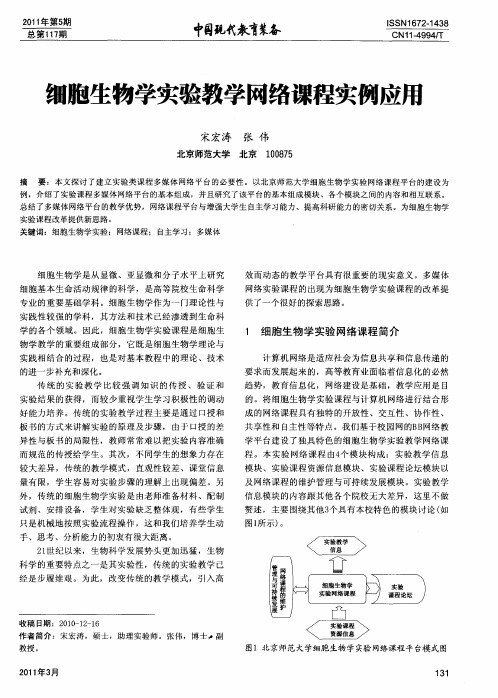
总 1期 第1 7
中 观代 装 国 孝 备
S 1 24 C 1 .3 S1 1 N6 4/ 8 N 499 - 7 r
-
细胞生物学实验教学网络课程实例应用
宋宏 涛
北京 师范大学
张 伟
北京 1 0 7 08 5
摘 要 :本文探 讨 了建立 实验类课 程多媒 体网络平 台 的必要 性 。以北京师 范大 学细胞 生物学 实验网络课程 平 台的建设为
细胞 生物 学是从显微、亚显微和分子水平上研究 细胞基本 生命 活动规 律的科学 ,是高等院校生命科学 专业 的重要基 础学科 。细胞 生物学作为一 门理论性与 实践性较 强的学科 ,其 方法 和技术 已经渗透到生命科 学的各 个领域 。因此 ,细胞生物学实验课程是细胞生 物学教 学的重要组成 部分,它既是细胞生物学理论与 实践相 结合 的过程 ,也是对 基本教程 中的理论 、技术
幻灯 片 文 件 。 1 12 推 荐 阅 时的跟踪最新 的生 命科 学领域,尤其是细胞生物学领域 内新技术 、新方 法、新 成果,通过推荐学生 阅读文献 的方式呈现给学 生 。比如在 “ 动物细胞的原代培养 ”实验 中,我们推 荐 了2 篇文献:一篇该方法 的原创性论文 ( 让学生 了解 这种实验 方法或技 能的起源和背 景) ;另外 一篇是最
信息模 块的 内容跟其他各个院校无大差异,这里不做 赘述 ,主要围绕其他3 个具有本校特 色的模 块讨论 ( 如
图 1 示 ) 所 。
/ 实验教学 \ 信息 \ /
量有 限,学生容易对 实验 步骤的理解上 出现偏差 。另
外 ,传统 的细胞 生物 学实验 是 由老 师准备材料、配制
的 。将细胞生物学实验课程与计算机 网络进行结合形
医学细胞生物学
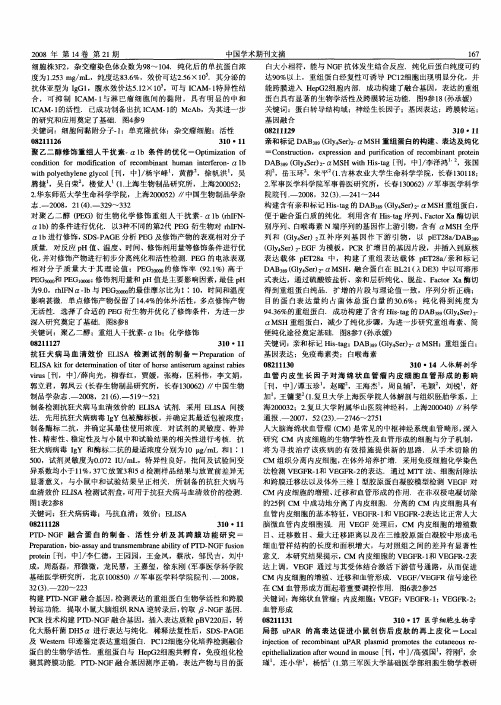
白大小 相符 ,能与 NG F抗 体发 生结合 反应 .纯 化后 蛋 白纯度 可约 达9 %以上 ,重组 蛋 白经复 性可 诱导 P 2 0 C1细胞 出现 明显分 化 ,并
能跨 膜 进入 H p 2 胞 内部. 成功 构 建 了融合基 因 ,表达 的重 组 eG 细 蛋 白具 有显 著的 生物 学活 性及跨 膜 转运 功能 . 图9 1 孙承 媛) 参 8( 关键 词 :蛋 白转 导结构 域 ;神经 生长 因子 ;基 因表达 ;跨 膜转运 ;
20 年 第 1 08 细胞 株3 2 F ,杂 交瘤 染 色体 众 数 为9 ~ 14 8 0 .纯 化 后 的单抗 蛋 白浓 度 为 1 5 / L,纯度 达8 . . 3mgm 2 36 %,效价 可达25 X1 其分 泌 的 . . 6 0 抗体亚 型为 IG1 g ,腹水 效价 达51 ×1 . 2 0 ,可 与 I A 1 C M一 特异 性 结 合 ,可 抑 制 IAM一 与 淋 巴 瘤细 胞 间 的黏 附 , 具有 明显 的 中和 C 1 IA 1 C M一 的活 性. 已成功 制备 出抗 IA 1 Mc b c M一 的 A ,为 其进 一步 的研 究和应 用奠 定 了基础 . 图4 参9 关 键词 :细 胞问 黏附 分子一 :单 克 隆抗 体 ;杂交瘤 细胞 :活性 1
式 表达 ,通 过硫 酸铵盐 析 、亲和 层 析纯 化、脱 盐 、F c rX at a酶切 o 得 到重 组 蛋 白纯 品. 扩增 的片段 与理 论 值一 致 ,序 列 分析 正确 ; 目的 蛋 白 表 达 量 约 占菌 体 总 蛋 白量 的3 . ;纯 化 得 到 纯 度 为 06 % 9.6 4 %的重 组 蛋 白.成 功构建 了含有 Hst 的 D B ( l4e)一 3 ja —g A 瑚 G ySr2 MS 重组 蛋 白,减 少 了纯化 步骤 , 为进一 步研 究重 组毒 素 、简 H 便纯 化途 径奠 定基 础. 图8 ( 承媛 ) 参7 孙 关键 词 : 和标 记 H s a;D 3 ( l S r2 MS 亲 i — g A 8 Gy e) t B 9 4 一 H;重组 蛋 白; 基 因表达 ;免 疫毒 素类 ; 白喉毒 素 0 2 13 8 110 30・ 4 人体 解 剖学 1 1 血 管 内皮 生 长 因 子 对 海 绵 状 血 管 瘤 内 皮 细 胞 血 管 形 成 的 影 响 [ ,中] 谭玉 珍。 刊 / ,赵 曜 ,王海杰 ,周 良辅 ,毛颖 ,刘 锐。 ,舒 加 王 镛斐 1 旦大 学上海 医 学院人 体解 剖与 组织 胚胎 学系 , , (. 复 上 海 20 3 ;2 旦大 学 附属华 山医院神 经科 ,上 海20 4)/科学 00 2 . 复 0 00 /
生物学相关网站

中国科学院微生物研究所(G /. 中国科学院生物物理研究所(G /. 中国科学院西北高原生物研究所(G /. 中国科学院水生生物研究所(G /hydrob/index_ihb.htm. 中国科学院上海生物化学研究所(G . 中国科学院上海细胞生物学研究所(G . 中国科学院上海微生物研究所(G /. 上海生物工程研究中心(G /. 上海国家基因研究中心(G /. 上海生命科学研究中心(G /. 中国微生物菌种保藏中心(G /im/lab1.html. 中国生物多样性信息中心微生物分部(G /cbic.html. 中国微生物信息网络系统(G /chinese/chinese.html. 中国医学细菌保藏管理中心(G . 分子生物学专业信息网(G /. 分子生物学与免疫学之家(G . 中国生物多样性信息系统内陆水体生物学分部(G . 华中理工大学生物物理与生物化学研究所(G /IBB/hust-gb.html . 生命科学BBS论坛(G /users/cat/catboard/catboard.htm. 分子生物学专业信息网(G /. 分子生物学专业信息(G /. 中国生态系统研究网络(G /. 蛋白质工程及植物基因工程国家重点实验室(G / . 上海人类基因组研究中心(G . 北京大学蛋白数据库(G /htm/med/peking.htm . 北京电子显微镜实验室(G /. 奇幻的恐龙世界(BIG5) /. 生物信息空间探索发射台/launch.html. 生命之树/tree/phylogeny.html. 生物学Web虚拟图书馆/biopages.html/biopages/journals.html. 生物学资源链接/. 生物科学资源/. 生物学资源服务http://pillo.unipv.it/em/surf.htm. 生物信息学资源/bioinfo.html. 生物学数据库/. 生物学教学信息资源服务/biopages/edures.html . 生物学会议预告/zrdocs/confs/confs.htm. 美国地质调查所生物资源部/. 美国国家生物信息基础设施NBII /nbii/index.html. 美国生物资源中心联网服务/nbs/nbshp2_2.htm. 国际生命科学研究所ILSI /. 美国国家生物技术信息中心. 美国生物技术高级研究中心/. 德国Wyraburg大学生物中心http://www.biozentrum.uni-wuerzburg.de/. 物种2000 /default.html. 英国Aberdeen大学生化学图象实验室/. 美国哈佛大学生物学实验室/. 百慕大生物研究站/. 分子生物工程研究中心/. 欧洲分子实验室http://www.embl-heidelberg.de/. 美国加州大学圣地亚哥分校生化遗传学/. 英国Sanger中心/. 欧洲分子生物学网络http://beta.ebmnet.unibas.ch/ebmnet/info.html. G Protein-Coupled Receptor数据库/GCRDBHOME.html. 细胞生物学/~cellab/. 细胞图片和电影/quill/. 细胞生物学词典/~julian/Dict.html. 细胞生物学实验室手册/~cellab/. 分子模型/modeling/. 生物化学信息服务/Heme-lron/. 人工生命研究信息系统. 蛋白/hopkins.html. 蛋白质http://expasy.hcuge.ch/sprot/sprot-top.html. 蛋白质数据库PDB //npdb/index.html(北京大学镜像网站). 蛋白质数据库信息服务QUEST . 生物流体力学BioFluids /. 微生物学和滤过性微生物学信息索引/WHSCL/medweb.microbiology.html . 微生物学电子公告板/microbbs/. 世界菌种保藏联合会世界微生物数据中心WDCM http://wdcm.nig.ac.jp/. 人类基因组组织HUGO /. 美国国家基因资源计划/. 基因组网络http://www.genome.ad.jp/. 人类基因组研究项目/. 美国斯坦福大学Motif Biolnformatics服务器/. 核酸数据库NDB /. 日本DNA数据库http://www.ddbj.nig.ac.jp/. Santa Fe研究所/. Jackson实验室/. 美国Brookhaven国家实验室/. 日本国家遗传学研究所/. 日本信息生物学中心/. 日本动物基因组数据库服务http://ws4.niai.affrc.go.jp/jgbase.html. 人类基因组差异研究常识问答/research/diversity.html. 用于遗传研究的计算机软件/. 网站GenLink /. 美国约翰.霍普金斯大学基因组数据库/. 澳大利亚国家基因组信息服务ANGIS .au/. LLNL人类基因组中心/bbrp/genome/genome.html . 英国人类基因组映射研究/. 虚拟基因组信息中心/VGC.html. 生命科学文摘/core/. 结构生物学杂志/. 生物技术杂志/. 遗传学杂志/. 生物化学杂志/. 生物世界今天/. 古生物学学会/orgs/paleo/homepage.html. 古植物学国际组织/palaeo/. 古生物学博物馆/. 恐龙展览厅/diapsids/dinosaur.html。
上海市生命科学知识点汇总

上海市生命科学知识点汇总
上海市生命科学知识点汇总
生命科学是研究生物体结构、生命过程、遗传信息和生物多样性等方面的学科。
以下是上海市生命科学的一些知识点:
1. 遗传学:研究基因的遗传规律和基因在细胞和个体遗传中的作用。
2. 基因工程:利用基因技术改造生物体的遗传信息和性状,包括基因克隆、基因转移、基因编辑等技术。
3. 细胞生物学:研究细胞的结构、功能和生理过程,包括细胞分裂、细胞信号传导、细胞凋亡等。
4. 分子生物学:研究分子生物学的结构、功能和互作关系,包括蛋白质合成、DNA复制、转录等。
5. 生物工程:利用生物体产生的化学物质或代谢产物进行工业生产。
6. 生态学:研究生物与环境的关系、生态系统的结构和功能、生物多样性等。
7. 医学生物学:研究疾病的发生机制和治疗方法,包括分子诊断技术、细胞治疗、基因治疗等。
8. 动物学:研究动物的生物学特性、分类和生态环境。
9. 植物学:研究植物的生物学特性、分类和生态环境,包括植物生长发育、营养代谢、植物分子生物学等。
10. 微生物学:研究微生物的形态、结构和代谢机制,包括细菌、病毒、真菌等微生物的研究。
以上是上海市生命科学的一些知识点,生命科学在现代社会中有着广泛的应用领域,对于人类健康和经济发展有着重要的意义。
中科院生化所往年录取信息
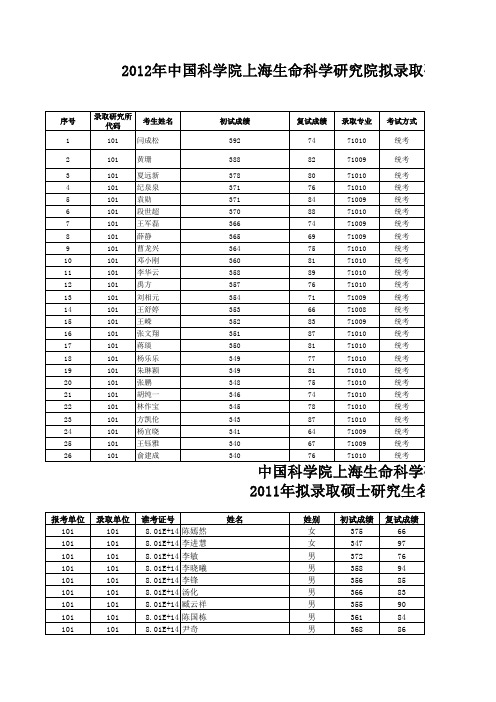
101 101 101 101 101 101 101 101 101 101
101 101 101 101 101 101 101 101 101 101
8.01E+14 8.01E+14 8.01E+14 8.01E+14 8.01E+14 8.01E+14 8.01E+14 8.01E+14 8.01E+14 8.01E+14
338 318 323 333 319 335 324 351 333 335 323 340 345 329 332 318
中国科学院上海生命科学研究院 通过初试和复试的攻读2007年研究生名单公示
性别 男 男 女 男 男 女
报考专业
71009 71009 71009 71009 71010 71009
7 8 9 10 11 12 13 14 15 16 17 18 19 20 21 22 23 24 25 26 27 28 29 30 31 32 33 34 35 36
101 101 101 101 101 101 101 101 101 101 101 101 101 101 101 101 101 101 101 101 101 101 101 101 101 101 101 101 101 101
2012年中国科学院上海生命科学研究院拟录取硕士研究生
序号 1 2 3 4 5 6 7 8 9 10 11 12 13 14 15 16 17 18 19 20 21 22 23 24 25 26 录取研究所代码 考生姓名 101 101 101 101 101 101 101 101 101 101 101 101 101 101 101 101 101 101 101 101 101 101 101 101 101 101 闫成松 黄珊 夏远新 纪泉泉 袁勋 段世超 王军磊 薛静 曹龙兴 邓小刚 李华云 禹方 刘相元 王舒婷 王嵘 张文翔 蒋琰 杨乐乐 朱琳颖 张鹏 胡纯一 林作宝 方凯伦 杨宜晓 王钰雅 俞建成 初试成绩 392 388 378 371 371 370 366 365 364 360 358 357 354 353 352 351 350 349 349 348 346 345 343 341 340 340 复试成绩 74 82 80 76 84 88 74 69 75 81 89 76 71 66 83 87 81 77 81 75 74 78 87 64 67 76 录取专业 71010 71009 71010 71010 71009 71010 71009 71009 71010 71010 71010 71010 71009 71008 71009 71010 71010 71010 71010 71010 71010 71010 71010 71009 71009 71010 考试方式 统考 统考 统考 统考 统考 统考 统考 统考 统考 统考 统考 统考 统考 统考 统考 统考 统考 统考 统考 统考 统考 统考 统考 统考 统考 统考
上海生命科学九年级知识点

上海生命科学九年级知识点生命科学是一门研究生物体的结构、功能和相互关系的学科。
它涉及生物的起源、进化、生理、生态以及与环境的互动等方面。
生命科学知识点丰富多样,下面将从分子生物学、细胞生物学、遗传学和生态学四个方面来探讨上海九年级生命科学的相关知识点。
一、分子生物学:1. 细胞的基本构成:细胞是生命的基本单位,包括质膜、细胞质、细胞器等组成部分。
2. DNA的结构和功能:DNA是生物体遗传性状的基础,具有双螺旋结构,携带了遗传信息。
3. RNA的类型和功能:RNA分为mRNA、tRNA和rRNA,参与基因的表达和蛋白质的合成过程中。
4. 蛋白质的合成:蛋白质是生物体的重要组成部分,通过转录和翻译的过程合成。
二、细胞生物学:1. 细胞的结构和功能:细胞由细胞膜、细胞质、细胞核和细胞器等组成,具有代谢、生长和分裂等功能。
2. 细胞膜的结构和功能:细胞膜是细胞的保护壁,控制物质的进出和维持内外环境的平衡。
3. 细胞分裂:细胞分裂是生物生长、发育和繁殖的重要过程,包括有丝分裂和减数分裂。
4. 细胞信号传导:细胞通过信号分子进行相互通讯和调节,如细胞因子、激素等。
三、遗传学:1. 遗传物质的传递:遗传物质通过遗传方式传递给后代,包括染色体、基因等的结构和功能。
2. 孟德尔遗传定律:孟德尔通过豌豆杂交实验,揭示了遗传规律,包括隐性和显性基因等。
3. 基因突变和遗传变异:基因突变和遗传变异会导致个体遗传性状发生改变,包括基因突变、染色体异常等。
4. 基因工程:通过改变和操控生物的基因来实现特定功能,例如转基因技术等。
四、生态学:1. 生态系统的组成和功能:生态系统由生物群落和非生物因素组成,通过能量流动和物质循环维持生态平衡。
2. 生物多样性:生物多样性是指地球上生物的种类丰富多样性,包括生物物种和基因的多样性。
3. 生态位和生态因子:生态位是生物在生态系统中的角色和职责,而生态因子则是影响生物存活和繁衍的环境因素。
网络资源在细胞生物学教学和学习中的应用
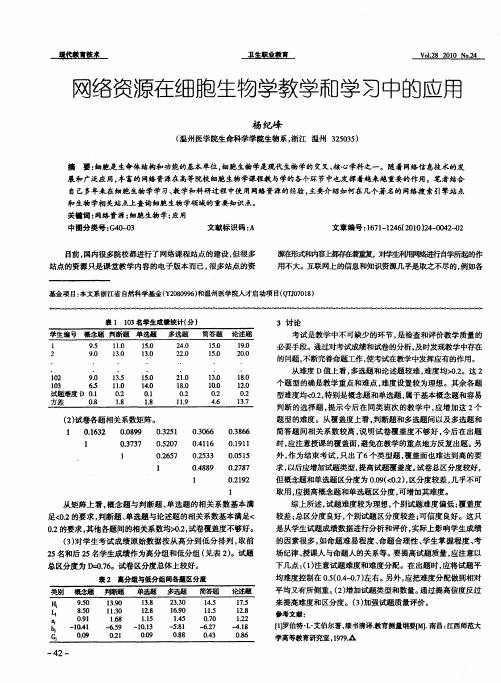
亡” 这一重要知识点为例, 介绍如何利用网络循序渐进地查询和
搜索各种相关的信息和知识 。
1 初步搜索 : 利用搜索引擎 G o l 进行查询 o ge
哈佛大学教授 Jh W・ibl编写的, on Km a l 以其名字命名的, 以经
典教 材为基础建立 的网站 ,其内容一直在不断地更新和扩充 。
个题型的确是教学重点和难点 , 难度设置较为理想。其余各题 型难度均< ., o 特别是概念题和单选题 , 2 属于基本概念题和容易
判断 的选择题 , 提示今后在同类班次 的教学 中 , 应增加这 2个 () 2试卷各题相关系数矩阵。
l 01 3 .6 2 0O 9 .8 9 03 5 .2 1 03 6 .0 6 03 6 .8 6
V0.8 0 0 No2 1 2 1 2 .4
网络资源在细胞生物学教学和学 习来自的应用 杨 纪峰 ( 温州医学院生命科学学院生物系 , 浙江 温州 353 ) 205
摘 要: 细胞是生命体结构和功 能的基本单位 , 细胞生物学是现代 生物 学的交叉、 心学科之一。随着网络信息技术的发 核 展和广泛应用, 丰富的网络资源在 高等院校 细胞生物学课程教 与学的各个环节 中也 发挥 着越来越重要 的作 用。笔者结合
题型的难度 。从覆盖度上看 , 断题和多选题间以及 多选题和 判 简答题 问相关 系数较高 , 明试卷覆盖度不够好 , 说 今后在 出题
时, 应注意授课的覆盖面 , 避免在教学的重点地方反复出题。另
上海生命科学研究院
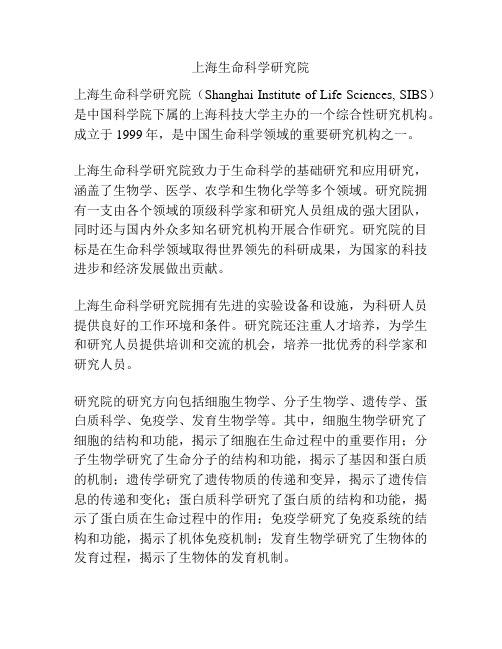
上海生命科学研究院上海生命科学研究院(Shanghai Institute of Life Sciences, SIBS)是中国科学院下属的上海科技大学主办的一个综合性研究机构。
成立于1999年,是中国生命科学领域的重要研究机构之一。
上海生命科学研究院致力于生命科学的基础研究和应用研究,涵盖了生物学、医学、农学和生物化学等多个领域。
研究院拥有一支由各个领域的顶级科学家和研究人员组成的强大团队,同时还与国内外众多知名研究机构开展合作研究。
研究院的目标是在生命科学领域取得世界领先的科研成果,为国家的科技进步和经济发展做出贡献。
上海生命科学研究院拥有先进的实验设备和设施,为科研人员提供良好的工作环境和条件。
研究院还注重人才培养,为学生和研究人员提供培训和交流的机会,培养一批优秀的科学家和研究人员。
研究院的研究方向包括细胞生物学、分子生物学、遗传学、蛋白质科学、免疫学、发育生物学等。
其中,细胞生物学研究了细胞的结构和功能,揭示了细胞在生命过程中的重要作用;分子生物学研究了生命分子的结构和功能,揭示了基因和蛋白质的机制;遗传学研究了遗传物质的传递和变异,揭示了遗传信息的传递和变化;蛋白质科学研究了蛋白质的结构和功能,揭示了蛋白质在生命过程中的作用;免疫学研究了免疫系统的结构和功能,揭示了机体免疫机制;发育生物学研究了生物体的发育过程,揭示了生物体的发育机制。
上海生命科学研究院的科研成果丰硕,取得了多项重要的科研成果。
研究院的科研成果在国际上具有很高的影响力,并获得了一系列的国内外科学奖励和荣誉。
研究院的科研成果在生命科学领域具有重要的实际应用价值,为国家的科技进步和经济发展做出了重要贡献。
上海生命科学研究院是中国生命科学领域的重要研究机构之一,以其卓越的科研实力和丰硕的科研成果,在国内外享有很高的声誉。
相信在未来的发展中,上海生命科学研究院将继续发挥其优势,为中国生命科学事业的发展作出更大的贡献。
上海生命科学研究院考研科目
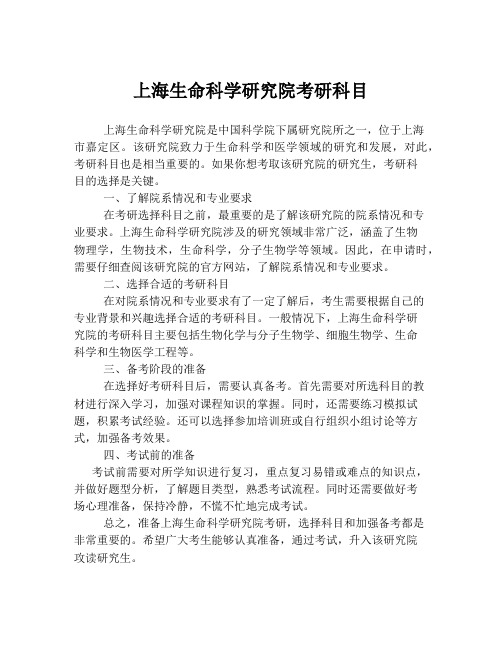
上海生命科学研究院考研科目
上海生命科学研究院是中国科学院下属研究院所之一,位于上海
市嘉定区。
该研究院致力于生命科学和医学领域的研究和发展,对此,考研科目也是相当重要的。
如果你想考取该研究院的研究生,考研科
目的选择是关键。
一、了解院系情况和专业要求
在考研选择科目之前,最重要的是了解该研究院的院系情况和专
业要求。
上海生命科学研究院涉及的研究领域非常广泛,涵盖了生物
物理学,生物技术,生命科学,分子生物学等领域。
因此,在申请时,需要仔细查阅该研究院的官方网站,了解院系情况和专业要求。
二、选择合适的考研科目
在对院系情况和专业要求有了一定了解后,考生需要根据自己的
专业背景和兴趣选择合适的考研科目。
一般情况下,上海生命科学研
究院的考研科目主要包括生物化学与分子生物学、细胞生物学、生命
科学和生物医学工程等。
三、备考阶段的准备
在选择好考研科目后,需要认真备考。
首先需要对所选科目的教
材进行深入学习,加强对课程知识的掌握。
同时,还需要练习模拟试题,积累考试经验。
还可以选择参加培训班或自行组织小组讨论等方式,加强备考效果。
四、考试前的准备
考试前需要对所学知识进行复习,重点复习易错或难点的知识点,并做好题型分析,了解题目类型,熟悉考试流程。
同时还需要做好考
场心理准备,保持冷静,不慌不忙地完成考试。
总之,准备上海生命科学研究院考研,选择科目和加强备考都是
非常重要的。
希望广大考生能够认真准备,通过考试,升入该研究院
攻读研究生。
- 1、下载文档前请自行甄别文档内容的完整性,平台不提供额外的编辑、内容补充、找答案等附加服务。
- 2、"仅部分预览"的文档,不可在线预览部分如存在完整性等问题,可反馈申请退款(可完整预览的文档不适用该条件!)。
- 3、如文档侵犯您的权益,请联系客服反馈,我们会尽快为您处理(人工客服工作时间:9:00-18:30)。
细胞生物学在线资料General sites/cell_bio/tutorials/cell_cycle/main.htmlThis site contains a brief, basic introduction; the cell cycle and mitosis subjects are separated; phase diagrams of cell cycle as well as the regulation of the cell cycle are shown. They relate this to cancer, and also talk about Cdk, MPf, and p53. There are some neat pictures describing mitosis, but the site over all is a bit too general./cell_bio gets you to a site with other connections. Rating: 3/This website is a general link to journal articles where one can obtain specific topics for an area of research interest. The site can be specific to molecular research and other biological/clinical fields. The more specific the field of research, the more technical the articles will be. There will probably be pictures that correspond to particular areas of interest. (5)/medlineplus/searchdatabases.htmlThis website is a general medline site with links to multiple topics. The site is organized by the National Library of Medicine. It can be specific to a particular topic. A search engine is present on the website to facilitate with retrieving specific topics. This website offers a basic overview.Dictionary of Cell Biology:/Biology/kabernd/cb//dictionary/%20www.mblab.gla.ac .uk/dictionary/A basic cell biology dictionary, this site can give you understandable definitions of key words and concepts related to the study of cell biology. For example: searching for "signal sequence" brings up a short explanation of the process, including reference to the topic "signal recognition particle".Search Engine for Links to Scientific Papers/medline/search-medline.shtml* Go to this site, then type "apoptosis" (or any other topic of interest) into the search engineBiological Membranes/biochemistry/bioc800/mem-lobj.htmThis site contains a group of four lectures about the structure and function of the biologicalmembrane. Each lecture has key bullet points that help the reader focus on the important areas. It also allows the reader to investigate the focus points further to get a more technical understanding of the general topics. This siteprovides good graphics that enhance the text. Rating: 5/cellbio/membrane.htmThis web page presents membrane structure and function on a general level using both real images from a microscope and computer diagrams. It asks questions and offersin-depth information. Each section begins with a question that is then answered. The site has key words scattered throughout the text that link to the moredetailed explanations. At the end it has a couple of links that provide information on other topics related to membrane structure. Rating: 5/~bmm5733/bilayer.htmlThis site focuses only on the phospholipid bilayer. It is relatively brief, but gives a good basic understanding of this topic. It also has helpful graphics. Rating: 3/obsil/membran.htmlThis web page begins with a general overview of the biological membrane. It has both text and graphics. We like this site because it contains thorough information on the functions of membrane proteins. It describes how different proteins attach to the membrane. It is a limited site without many graphics. Rating: 3/cell4.htmThis is a small site, but it is completely different from any of the others. It describes what happens to the phospholipids and the membrane as aging occurs. It offers a nutritional approach to maintaining a healthy plasma membrane. Thus, it shows how the biological membrane fits into daily life through nutrition. Rating: 5Protein Synthesis/AB/GG/This site has many detailed graphics on all aspects of protein synthesis and DNA replication. One can also find information on many other topics pertaining to viruses, genetics, cell division, etc. Our favorite site./~rjh9u/dnaprot.htmlThe graphics on this site are very helpful in providing a better understanding of protein synthesis and related topics because they utilize movement. There is also a link for a tutorial on DNA structure, replication, transcription, and translation./bc/ahp/BioInfo/SD.TransTrans.HP.htmlA great step by step pictorial of translation is found on this site. It describes eachcomponent needed for translation. Has a brief description of transcription accompanied by colorful graphics./departments/bioscience/lec2.htmlThis website has a basic overview of DNA replication as well as protein synthesis. Very helpful in establishing a foundation for understanding the process of protein synthesis./bio/bio181/biobk/biobookprotsyn.htmlBegins with an historical summary of how the "one gene one enzyme" theory was proposed. Has basic background information on hemoglobin, viruses, DNA replication, transcription, and translation. Also has a chart listing all of the codons for each amino acid.Protein Targeting/Biology/kabernd/cb/www.biochemtech.uni-halle.de/PPS2/course/section4/tr ansport.htmlOur top pick, this site is well informed and organized, even containing brilliant rasmol images to illustrate specific examples, as well as a good cartoon of the process of SRP aided translocation. It provides a good overview with some detail as well, including examples of signal sequences and even references. However, it is most thorough only in covering translocation and the fate of proteins assembled in the cytoplasm. In this way it does not provide the full picture of protein targeting that thecambridge site delivers. This is a topic specific site. Rating: 4.5/~jkimball/BiologyPages/P/ProteinKinesis.htmlAnother very good site, this time with a colorful embedded figure. The information is slightly less detailed, but concisely presented in outline form, making easy going for the student seeking a broad but topic specific overview. A good feature is that key terms are hyperlinks to short explanations. Rating - 4/~sa232/tex/MVSTIA_4-8_Shy/Something of an overview site, students studying protein targeting willfind the following URL the most helpful:/~sa232/tex/MVSTIA_4-8_Shy/node8.html#SECTION00200000000000000000 0000000000000 The site contains the lecture notes for a biology class and is very well organized conveying the information accurately and easily. Unfortunately, the figures seem not to work, at least not on all computers. It goes into a fair degree of detail while stopping short of experimental evidence. The site contains very thorough and extensive information on the topic of protein targeting, but not on other topics and is therefore not a good general information site. Rating - 4/waters/research.htmlThis site provides a highly technical report of current research done by a group atPrinceton, covering specifically the process of targeting vesicles throughout the cell. It is a text only page with one hyperlinked and somewhat unhelpful figure. It is so specific to the topic as to cover only a small aspect of it - the targeting process for membrane associated and excreted proteins. Rating - 2Intracellular Traffic/~molbio/mcb520/lecture7.html/~molbio/mcb520/lecture8.htmlDetailed description of devices cells use to separate and store substances (lecture7), and how a cell moves these substances (lecture8). These pages are very detailed and likely accurate, since they come from an academic institution. General: 3/cellbio/recend.htmSince cells often transport substances contained/protected by lipid layers, exo- and endocytosis are important mechanisms in intracellular transport. This site provides overviews, self-tests, and many images and links. Specifically, this page focuses on ligand-receptor mechanisms for triggering endocytosis. Specific: 4http://www.ktl.fi/bios/know/traffic.htmlThis site was produced by an individual working with intracellular transport mechanisms. This page is an introduction to the types of problems a cell faces when these transport pathways are not functioning properly. General:4http://shubashi.physiology.rwth-aachen.de/bs/erys/shapes/Here they present the results of vesicle shape calculations sorted by constraints on volume (v) and area difference (h). A well-made Java program. Very useful if you ever need to determine the shape a vesicle will take based on these parameters. Specific: 4/%7ejkimball/BiologyPages/P/ProteinKinesis.html#rerA very comprehensive site discussing protein kinesis. Good illustrations, and several links to more related information. The author gives good credentials, and seems to be well organized. Specific (but linked to a General index): 5/labs.shtml#membranesThis site provides a list of lab exercises that pertain to investigations into Membranes, Organelles and Vesicle Trafficking. Specific: 2/cbmb/pb1labob.htmlWeb summary of Nature, Volume 389, Pages 81-85 1997 that contains many quality animations (note: the movie player plug-in must be installed). Discusses experiments regarding the transport pathways of the Golgi apparatus. Specific: 3Cell Scaffolding/This site summarizes research on actin at the Brigham and Women's Hospital. It has lots of information and some interesting movies about cell motility and its relation to the cytoskeleton. Rank: 4./bio/bio181/BIOBK/BioBookCELL2.htmlThis is a portion of an online biology textbook. It contains very good cartoon illustrations of cellular scaffolding components and a description of their use in inter- and intracellular motility. Rank: 5./CBMB/uobf3a.movThis is a movie of vesicular traffic into the Golgi, visualized with Green Fluorescent Protein. Not much information about cellular ,scaffolding, but a nice way to visualize the intracellular motion madepossible by the scaffold. Rank: 2./~mwd/cell_www/chapter2/skeleton.htmlThis site is currently incomplete/under construction, but it has some interesting facts about centrioles and actin. Further entries regarding other components of the cytoskeleton are presumably forthcoming. No images. Rank: 2.http://web-mcb.agr.ehime-u.ac.jp/bunnshi/sec7.htmThis site provides an excellent summary of the unique features of cellular scaffolding in plant cells. No images. Rank: 4Molecular Motors/movies/actin_myosin_gif.htmlActin myosin crossbridge 3-D animation. The animation shows the need for one ATP to make the myosin complex "walk".http://199.17.138.73/berg/ANIMTNS/kinesin.htmThis site has a diagram showing how kinesin pulls "things" down the microtubule away from the cell in the negative to positive direction. Also, this site contains a link to more information on dynein./hypertour.htmlA very good site decribing the role of molecular motors. The site contains links to diagrams which further explain how molecular motors "walk" along the microtubules in order to pull chromosomes into position./ascb/mbc/brochuretxt.htmThis site tells why molecular motors are so important to study. It also gives a detailed description of myosin versus kinesin, including various universities studying this topic./faculty/SMB.htmlDr. Steven M. Block discusses his research interests in molecular motors andwhy he feels it is important to study them. It also gives 3 reasons why amotor mechanism is difficult to construct.Intercellular signaling (Cell Signaling)/biology/faculty/goetz.htmlA very specific website that pertains to intercellular signaling. This website was developed by one author, Dr. Frederick W. Goetz, a professor at the University of Wyoming. Dr. Goetz is studying the mechanisms and hormonal regulation of ovulation in zebrafish. More specifically he is determining the genes responsible for mutations involved in oogenisis and spermatogenisis. There are images present. (5)/pub/l/ldasso/A website created by Dr. Leonardo Dasso of the University of Massachusetts Medical School. Included in this website is a specific, but brief, overview of Dr. Dasso韘research on the function of Ca2+ and cAMP in intercellular signaling. More specifically, Dr. Dasso researched the role of Ca2+ and cAMP in increasing the beat frequency of cilia in epithelial cells. This website also has links to selected publications and other pertinent articles. (4)/dept/gsas/anatomy/cndb_it.htmlThis website is a link to Dr. Richard H. Kessin of Columbia University. It can be found by double clicking Dr. Kessin韘name in "Intercellular signaling." This is a specific website that can be a link to other articles written by this professor and other professors that deal with intercellular signaling. Dr. Kessin韘website focuses on the evolution and mutagenisis of Dictyostelium discoidenum. Minimal pictures are present. (3)Intracellular Signaling (Receptors, 2nd messengers)/CollegePark/Lab/1580/cdc42.htmlThis site gives a very thorough and easy to understand view of Cdc42 (a G-protein) and its uses inside the cell. This site gave a simplified and clear presentation of the processes involving Cdc42. There are links along the way through the page to other pages that go into detail about G-proteins in general, cell cycle control, and other topics important for the understanding of the functions of Cdc42. This page also has several diagrams along with text to further the explanations of the topic, and at the bottom provides links to other material concerning cellular biology.:7088/.data/allied-data/interactive-fly/aignfam/camplern.htmThis page contains links to webpages that discuss G-proteins, cAMP, and other cell related chemical reactions and proteins. This page is good as a resource for intracellular communication "techniques" used by cells and gives fairly lengthy overviews of what these proteins do, although most of this site is directed at the cAMP second messenger system process. Even though it lacks any diagrams, it is still a good site for written information./biology/courses/immunology/flash/ip3.htmlThis site is operated by a Davidson Professor (Dr. Campbell) and portrays a step by step animated visual of an IP3 signal transduction pathway. This is the only visual that this site shows, however it is very helpful in understanding a basic intracellular communication technique in a very comprehensible manner./st_over.htmlAriad, a pharmacological research company that explores "intracellular protein interactions that make up signal transduction pathways," has established this site. The company韘focus is the creation of small molecule drugs that inhibit signal transduction pathways. We chose this as one of our top sites for its diagrams as well as its links to more specific information about the cell proteins it researches.http://www.clarke-inst.on.ca/research/cellular_communication.htmlThis site reveals the mission of Dr. Jerry Warsh as he attempts to elucidate the significance of intracellular signaling disturbances in manic depressive illness (bipolar disorders). This site describes the importance of calcium levels as cell signaling devices and G-proteins as surface membrane protectors. Though lacking diagrams and specifics of their research it presents an interesting explanation into symptomatic effects of errors in intracellular signaling processes.Protein Degradation/protdeg/lyso.htmlgreat overview of lysosomes--recent research on protein degradation accessible from here/dictionary/a great place to start a search on proteins and other topics-- provides links to tons of sites/protdeg/home.htmlbasics of protein degradation: how, why then moves into to proteolytic systems/~mbzmail/students/ub/ubindex.htmlgood 3-D's of protolytic molecules great explanation of the ubiquitin/proteasome pathway/proteins.shtmlgives links to other great sites on protein degradationCell Cycle/~kmcmahon/AP%20Bio%20Lectures?Cell%20Division/Cell%20Cycle.html Cycle.htmlThis site showed the phases of the cell cycle in a flow diagram, showed cell cycle variation (interesting); it also showed the difference between external and internal regulation utilizing diagrams. This site alsodiscussed cancer implications. It has both images and animation, most specifically the mitosis picture). This site was good in that it broke down information to the basics, but there was not much specific information, but more on the general sense. Rating: 4/instruct/mcclean/plsc431/cellcycleThis site proved very interesting, showing the factors controlling the entrance into mitosis, further showing diagrams exhibiting this entrance. (gene --> protein --> function) It goes on to describe cancer. The only drawback was its specificity - this site was a bit too specific when wanting an overview on the cell cycle, since it concentrated more on the technical factors. Rating: 4/~melcher/MG/MGW1/MG1331.htmlThis site showed the unicycle/bicycle interpretations of the cell cycle, and also showed the basics of mitosis. It had nice, simple diagrams and links to other interesting sites. The animations of mitosis were pretty neat since they showed the cross over, but it was not extremely technical or too informative.Rating: 3.5/~arames/CELLCYCLE.htmlThis site showed an overview of the cell cycle, had great graphics to animation showing the transition from G1 to S to G2 to mitosis. It had great general information, but still was of a good caliber of learning, meaning that it was not too basic. It had a neat "supplementary guide" link which had a cute little quiz. Shannon and I liked this one the best. Rating: 5Virtual Biology:/%20%20www.seoulin.co.kr/~virbio/index.html%20%20%20www.seoulin.co .kr/~virbio/index.htmlReally cool animation on the cell cycle, as well as other cell processes and structures. Easily accessed through the Davidson bio www links page.The Biology Project:/Biology/kabernd/cb//cell_bio/tutorials/cell_cycle/ce lls1.htmlThis site, established and updated by the University of Arizona, has a tutorial of the cell cycle, along with nice accompanying graphics. At the end of the tutorial is a challenging multiple choice quiz to test what you just learned.Cell Cycle Regulation:/CollegePark/Lab/1580/cycle.htmlThis website provides a detailed description and images concerning cell cycle control and apoptosis. The overall objective of this site is to discuss cell homeostasis. The five sections of this site are "Rb Pathway", "p53 Pathway", "Pdc42", "Apoptosis", and "integrins".The Forsburg Lab Pombe Pages:/~forsburg/%20This website discusses in detail the cell cycle and fission within yeast. The site has main segments discussing cell division and DNA replication using diagrams and figures for explanation. The structure and function of chromatids are also explained.ApoptosisApoptosis Interest Group/sigs/aig/index.html* Explanation of apoptosis * Information on Apoptosis Interest Group * List of research groups and their workApoptosis Online/index.htm* Apoptosis forum for posting questions, answers, etc. * Career information * Community Center with meeting schedules and grant information * Reference libraryJ. Kimball's Apoptosis Page/~jkimball/BiologyPages/A/Apoptosis.html* Outline of cell death * Explanation of why cells commit suicide * In-depth diagrams * Mechanisms of apoptosis * The role of apoptosis in cancer, AIDS, and organ transplants. This site has an easy to follow outline, good explanations, and also relates apoptosis to diseases, such as cancer and AIDS.University of Maryland/CollegePark/lab/1580/apoptosis.html* Examples of programmed cell death * DiagramsIntroduction to Apoptosishttp://www.acs.ucalgary.ca/~browder/apo_intro.html* References * Description of apoptosisLinks to Apoptosis Sites/CapeCanaveral/4748/apoptosis.html/techserv/apoptosis/index.htmThis site gives good graphics, a slide show which can be downloaded, the proposed pathway, and hot links to other apoptosis web sites.wwwpeople.unil.ch/Martinon.Fabio/science.htmlThis site has an excellent introduction about apoptosis, diseases related to this topic, labs currently working on it, and links./cancer/apopto~1.htmThis site gives the current research in this field.www.acs.ucalgary.ca/%7Ebrowder/apoptosis.htmlThis site gives good descriptions of why it developed and thorough explanations as it what apoptosis is, and how it works./apoptosis.shtmlThis site has many links to other apoptosis web sites.。
